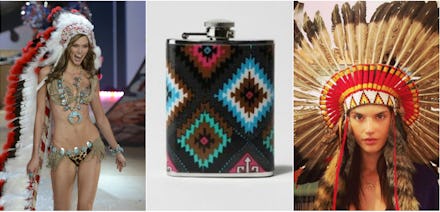5 Items Fashion Loves to Steal From Native American Culture

Just when you thought the fashion industry had gotten the memo that Native American headdresses aren't a trend, Topshop goes and introduces its "ornate feather headdress."
It's the latest snafu in a long-running history of fashion designers and companies, from H&M and Urban Outfitters to Asos and Victoria's Secret, cribbing items from Native American culture, many of which are sacred. Native Americans have a long history of marginalization in the United States, and the fashion industry has kept the tradition going by borrowing, taking inspiration without credit or blatantly copying from Native culture.
It's not that Native American culture can't inspire contemporary designers, said Jessica R. Metcalfe, Ph.D. and creator of Beyond Buckskin, a blog centered on Native American fashion, to Mic. It's about honoring and taking the source into consideration:
"If you're trying to rip off Native American culture, without having any connection to Native people, I think that that is unethical because a lot of these companies are making a lot of money off of the Native American trend and often selling the legacies that we've built, and none of that money or recognition goes back to Native people. So it is as if our culture has been hijacked without our consent."
That can mean including indigenous designers in the creative process, or ensuring the profits don't entirely elude Native sources. It also means getting educated about the diversity and intricacies of Native American culture.
"At this point, they're taking our voices and our designs from us," Bethany Yellowtail, a Native American designer, previously told Mic. "They don't acknowledge us as living people and nations. This is not just fashion, it's part of our tribal identities."
What's getting cribbed without acknowledgment? And how can everyone do better? Here's are five trends that have Native American roots which we shouldn't ignore. Listen closely, Topshop.
1. The Native American headdress
It's sacred. Full stop.
The headdress' meaning varies from nation to nation, Metcalfe said, but it's is commonly designated as a sacred item that must be earned, usually by males. In some cultures, good deeds are rewarded with the gifting of eagle feathers; when a man has accumulated a lot of feathers, he can then make a headdress, she said. Women, too, sometimes wear feathers during special ceremonies.
Yet the Native American headdress tops the list of items that fashion has culturally appropriated without any regard to its origins or cultural significance.
"I think that whenever you are wearing a Native American headdress when you're not a Native person," Metcalfe said, "you are actively engaging in the destruction of our cultural practices by negating all of those values."
2. Moccasins
At this point, moccasins have become a shoe category unto themselves for retailers. But the design has clear origins in Native culture. The exact designs vary from tribe to tribe, but were historically usually made of a soft leather like deerskin.
Since moccasins aren't a sacred item, they can be worn by everyone, Metcalfe said. But since they've been reimagined by different companies, Metcalfe said that shoppers could avoid buying from companies that have no direct tie to the Native culture that first inspired it.
As she put it to Mic, "Are you giving your money to a company that is... hijacking someone else's culture, or can you instead put the money back into the community that invented this specific form of footwear?"
3. Fringe
Fringe isn't a style that's exclusive to Native American culture. It can, however, be murky territory when used as a symbol to caricature Native American culture.
Native American clothing sometimes featured fringed detailing on skirts, jackets and moccasins for decorative and functional purposes. Warriors who wanted to disguise their paths would use long fringe attached to their moccasins, the fringe sweeping the ground as they walked to erase their foot patterns.
4. Textiles and beadwork
Native American textiles and beadwork are difficult to characterize since each nation can have distinct colors or designs, Metcalfe said. A common thread, however, is the use of geometric patterns, which along with colors can help tell stories, she said. For instance, a design might be representative of surrounding landscape and make references to the sky, mountain, river or trail.
Certain beadwork and patterns also signified certain life events or family relations. Today, the significance of these beaded patterns or prints are often overlooked.
5. Turquoise
The American Southwest is known for turquoise stone and the belief systems associated with it, Metcalfe said. While turquoise isn't worn or used exclusively by Native Americans, it is important to understand that it could have a special significance or reference to water or the sky, she said. "There are meanings that go beyond just 'it's a pretty color,'" she said.
"We have four sacred stones, and the No. 1 is turquoise," Navajo silversmith Mae Peshlakai told Al-Jazeera earlier this year. "It's your connection to Mother Earth and Father Sky and living in harmony with everything that exists in between."
Those are details the average non-Native shopper wouldn't know, of course. So just ask.
"If you're doing a blatant rip-off of a Native American style or Native theme," Metcalfe said, "then you're negating the fact that there are over 500 separate individually recognized Native American nations and that we're all different. We're all diverse, and we have a lot to offer the world, and we would like some recognition in that."